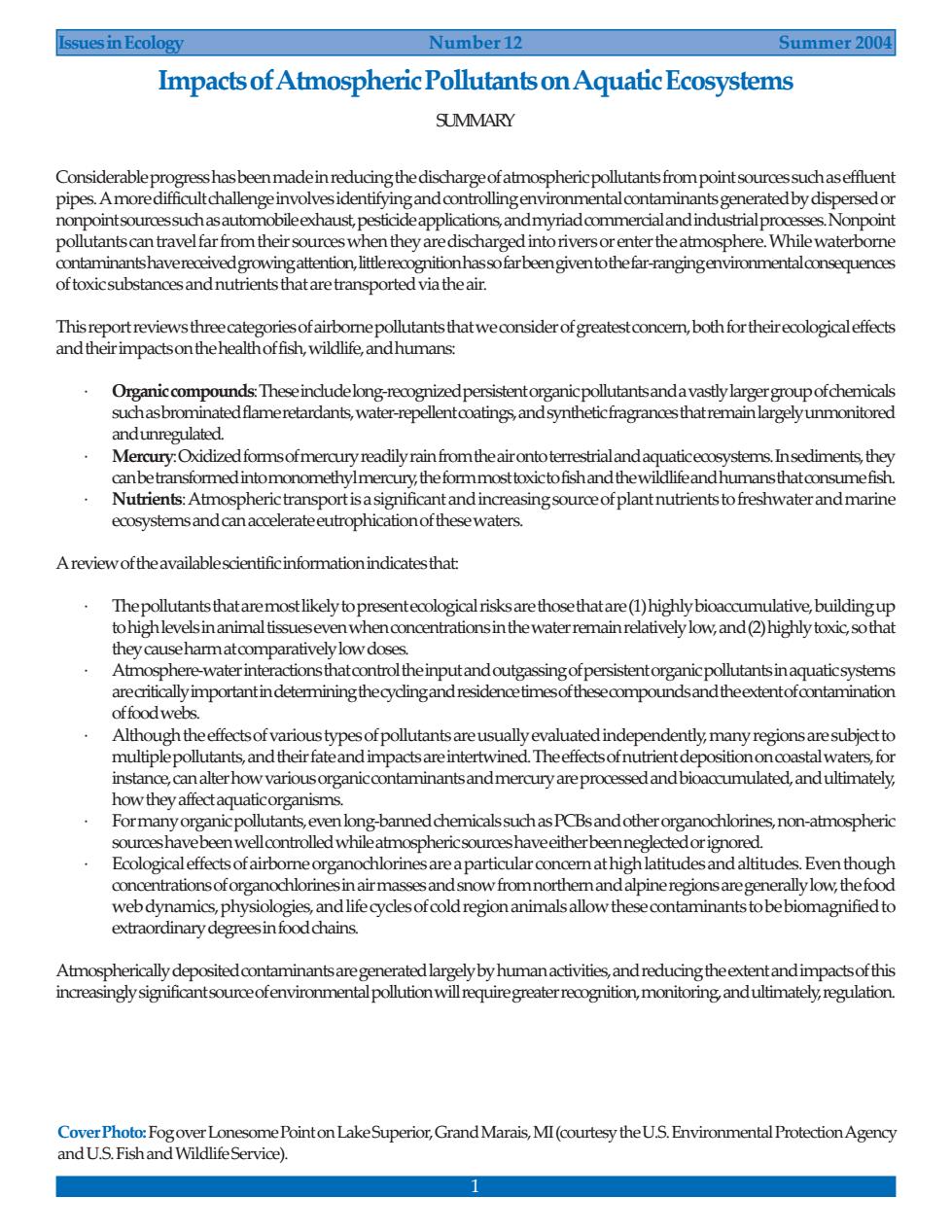正在加载图片...

Issues in Ecology Number 12 Summer 2004 Impacts ofAtmospheric Pollutants on Aquatic Ecosystems SUMMARY Considerable progress hasbeen made in reducing the dischargeofatmosphericpollutants from point sources such as effluent pipes.Amoredifficult challenge involvesidentifyingand controllingenvironmentalcontaminants generatedby dispersedor nonpoint sourcessuch as automobileexhaust,pesticideapplications andmyriad commercalandindustrialprocesses.Nonpoint nitionhas so farbeengiventothe far-rangingenvironmentaloonsequences oftoxicsubstancesand nutrients that aretransported via theair. ds Theseindudelong-regnizedpersistentorganicp Mercury:Oxidized formsofmercury readily rain fromtheairontoterrestrialandaquaticeoosystems Insediments,they canbetransformedintomonomethylmercury,the formmosttoxicto fish and thewildlifeandhumansthat consume fish Nutrients:Atmospherictransport is asignificant and increasingsource ofplant nutrients to freshwater and marine ecosystems and can accelerateeutrophicationof thesewaters. Areviewoftheavailablescientificinformationindicates that Thepollutants thataremostlikely topresentecological risksare those that are(1)highly bioaccumulative,buildingup tohigh levelsin animal tissueseven when concentrationsin the water remain relatively low,and (2)highly toxic,sothat they causeharmatcomparativelylow doses Atmosphere-water interactions that control the input and outgassing of persistent organic pollutants in aquaticsystems of food webs. Although the effectsof va any region e,ca For many organicpo es,non-atmospheri concentrations oforganochlorinesin air masses and snow fromnorthem andalpineregionsaregenerally low,thefood web dynamics,physiologies,and life cycles ofcold region animalsallow these contaminants tobebiomagnified to extraordinary degreesinfood chains. Atmospherically deposited contaminantsaregenerated largely by human activities,and reducing the extent andimpactsofthis increasingly significantsourceofenvironmentalpollution will requiregreater recognition,monitoring andultimately,regulation. over Lonesome Pointon LakeSuperior,GrandMarais,MI(courtesy theUS EnvironmentalProtection Agency Service)1 Issues in Ecology Number 12 Summer 2004 Impacts of Atmospheric Pollutants on Aquatic Ecosystems SUMMARY Cover Photo: Fog over Lonesome Point on Lake Superior, Grand Marais, MI (courtesy the U.S. Environmental Protection Agency and U.S. Fish and Wildlife Service). Considerable progress has been made in reducing the discharge of atmospheric pollutants from point sources such as effluent pipes. A more difficult challenge involves identifying and controlling environmental contaminants generated by dispersed or nonpoint sources such as automobile exhaust, pesticide applications, and myriad commercial and industrial processes. Nonpoint pollutants can travel far from their sources when they are discharged into rivers or enter the atmosphere. While waterborne contaminants have received growing attention, little recognition has so far been given to the far-ranging environmental consequences of toxic substances and nutrients that are transported via the air. This report reviews three categories of airborne pollutants that we consider of greatest concern, both for their ecological effects and their impacts on the health of fish, wildlife, and humans: · Organic compounds: These include long-recognized persistent organic pollutants and a vastly larger group of chemicals such as brominated flame retardants, water-repellent coatings, and synthetic fragrances that remain largely unmonitored and unregulated. · Mercury: Oxidized forms of mercury readily rain from the air onto terrestrial and aquatic ecosystems. In sediments, they can be transformed into monomethyl mercury, the form most toxic to fish and the wildlife and humans that consume fish. · Nutrients: Atmospheric transport is a significant and increasing source of plant nutrients to freshwater and marine ecosystems and can accelerate eutrophication of these waters. A review of the available scientific information indicates that: · The pollutants that are most likely to present ecological risks are those that are (1) highly bioaccumulative, building up to high levels in animal tissues even when concentrations in the water remain relatively low, and (2) highly toxic, so that they cause harm at comparatively low doses. · Atmosphere-water interactions that control the input and outgassing of persistent organic pollutants in aquatic systems are critically important in determining the cycling and residence times of these compounds and the extent of contamination of food webs. · Although the effects of various types of pollutants are usually evaluated independently, many regions are subject to multiple pollutants, and their fate and impacts are intertwined. The effects of nutrient deposition on coastal waters, for instance, can alter how various organic contaminants and mercury are processed and bioaccumulated, and ultimately, how they affect aquatic organisms. · For many organic pollutants, even long-banned chemicals such as PCBs and other organochlorines, non-atmospheric sources have been well controlled while atmospheric sources have either been neglected or ignored. · Ecological effects of airborne organochlorines are a particular concern at high latitudes and altitudes. Even though concentrations of organochlorines in air masses and snow from northern and alpine regions are generally low, the food web dynamics, physiologies, and life cycles of cold region animals allow these contaminants to be biomagnified to extraordinary degrees in food chains. Atmospherically deposited contaminants are generated largely by human activities, and reducing the extent and impacts of this increasingly significant source of environmental pollution will require greater recognition, monitoring, and ultimately, regulation